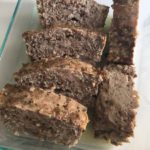For the past three weeks, I have been trying out an AIP + Low FODMAP diet. The reason I’m doing it is because I’m currently on a gut healing regimen (through my functional MD) and I listened to a podcast episode with Chris Kresser that explained how he typically recommends a low-FODMAP diet for those trying to treat candida and bacterial overgrowth in the gut. He says he recommends this because, contrary to popular belief, many of the candida diets that cut out ALL starch and ALL sugars (even naturally occurring ones in fruit) are actually counterproductive. According to Mr. Kresser, this is because if you eliminate all sugars and all starch, you run the risk of actually going into ketosis, and candida feeds on ketones just the same as it does sugar and starch. Thus, these types of diets can even worsen your condition.
For me though, I did also decide to omit some starches (like my beloved sweet potatoes), as well as any added sugars, including those allowed on the autoimmune protocol like maple syrup, molasses and coconut sugar. I chose to do this because it sounded like it would make the most sense for me and my health goals, and I was also dealing with some slight blood sugar issues, so I figured this would be a nice break for my system.
When I decided to do this, my first reaction was, “CRAP – I have to eliminate even MORE foods??” And even though I was the one choosing this path, I couldn’t help but feel deprived and bummed from the get-go. Plus, who wants to give up sweet potatoes right at the beginning of Fall? That’s just madness.
Luckily, it hasn’t been as rough as I expected and in fact – after only about 3 days of following low FODMAP, I began noticing positive changes in my digestion, energy levels and brain fog levels. I had never even entertained the idea that I may have a FODMAP sensitivity (i.e. I didn’t want that to be true), but now I’m starting to think maybe that’s been a big problem for me, particularly because I mean – I use A LOT of garlic and onion. I pretty much use that to flavor everything I eat. So…this has been really interesting to see how I feel without those in my life.
Overall though, I’d say the hardest part about this diet change has been that there’s not that many recipes specifically for this variation of AIP! Luckily, I found Christina’s 28 Days of Low FODMAP AIP, which has been a literal godsend. Additionally, The Paleo Approach Cookbook does contain special notes and recipe adjustments for low FODMAP. Still, that’s about all there currently is.
So, to hold me over for a few more weeks (I’m trying to do 60 days of low FODMAP as part of the gut healing regimen), I started taking matters into my own hands. Thus was born, this meatloaf recipe.
It’s Italian style in that I use a variety of Italian herbs to help flavor it, and the 50/50 split between pork and beef gives it a nice depth of flavor. Plus, it’s super easy to make so – that’s always a plus in our household. We could hardly keep ourselves from eating the whole loaf in one night!
Hope you enjoy. 🙂
- 1 lb ground beef
- 1 lb ground pork
- 1/4 tsp of each following ingredient: dried marjoram, dried basil, mace
- 1/2 tsp of each following ingredient: dried chives, dried oregano, dried rosemary
- 3/4 tsp sea salt
-
Preheat oven to 400F
-
Mix all ingredients together in large bowl
-
Press meat mixture into a 9x5 loaf pan
-
Bake for 40-45 minutes, or until center is no longer pink
-
Cut into 6 slices and serve
I like to serve this with some mashed root veggies. To be safe on low-FODMAP, I'd recommend doing a parsnip-carrot-turnip mash. For this, just boil all root veggies and process in a food processor along with some coconut oil and sea salt to taste. It's a delicious side for this meatloaf!





Hi Mitch,
Thanks for sharing your experiences with Low FODMAP/AIP eating. I was wondering, what lists are you using for Low FODMAP? Or are you using an app? I’ve seen different lists with different info, so I’m curious as to which one(s) you’ve found helpful.
Thanks,
Tam
Hi Tam – thanks for reading along. That’s a great question and yes it is surprising how much conflicting information there is out there regarding low FODMAP foods. I did a lot of research and ultimately chose the one I felt was most comprehensive and that resonated most with me and what I understood about low FODMAPS. That list is: http://www.ibsdiets.org/fodmap-diet/fodmap-food-list/ Hope that helps!
Is there an AIP plus low FODMAP list in existence? With the order for reintroduction? I have 6 weeks to get my health back!
Diane Sanfillipo’s book Practical Paleo has low-FODMAP modifications for many of those recipes. Just another place to look. 😉 Best if luck!
Thanks for the suggestion!
Thank you for your post and recipe. Sounds similar to my story in that I used tons of garlic and onions in everything and find that I feel much much better without them. I so miss them though. I also used Christina’s resource because I felt lost and confused at first. I’m having some histamine issues also and have adapted to that as well. Good luck on your continuing healing journey.
Thanks, Andie! Nice to hear you could relate to this. Christina’s book has definitely been a lifesaver for me, too!
I highly suggest using the Monash App for your low FODMAP list. The reason that there are conflicting lists is because the research is cutting edge. As research changes, the lists change by necessity. The Monash App is kept up to date very well.
OMG What! “He says he recommends this because, contrary to popular belief, many of the candida diets that cut out ALL starch and ALL sugars (even naturally occurring ones in fruit) are actually counterproductive. According to Mr. Kresser, this is because if you eliminate all sugars and all starch, you run the risk of actually going into ketosis, and candida feeds on ketones just the same as it does sugar and starch. Thus, these types of diets can even worsen your condition.”
I did not know this! My kids and I all have a Candida Overgrowth so I am glad I read this and haven’t cut out all sugars, thanks for this article!
This meatloaf sounds delicious.
Crazy, right? I found that interesting as well!